PETER ABLINGER - QUADRATUREN

![]()
![]()
Principles
Quadraturen ("Squarings") is a cycle of installation-, electroacoustic-, and concert-pieces,
or
one work that appears in one instance as symphony orchestra,
in another as sound installation,
and in the next as a computer-controlled player piano.
(1)
The first step is always an acoustic photograph ("phonograph").
This can be a recording of anything: speech, street noise, music.
(2)
Time and frequency of the chosen "phonograph" are dissolved into a grid of small "squares"
whose format may, for example, be 1 second (time) to 1 second (interval).
(3)
The resulting grid is the score, which is then to be reproduced in different media:
on traditional instruments, computer controlled piano, or in white noise.
The reproduction of "phonographs" by instruments can be compared to photo-realist painting, or - what describes the technical aspect of the "Quadraturen" more precisely -with techniques in the graphic arts that use grids to transform photos into prints.
When using humanly played instruments the grid has to be enlarged (slowed down) to remain playable - thus the result of the transformation is not so much a reproduction of the original but an approach to or a situation of comparison between instrumental sounds and the original sound source.
Using a smaller grain, e.g. 16 units per second (about the limit of the player piano), the original source approaches the border of recognition within the reproduction. With practice listening the player piano can even perform structures possible for a listener to transpose into/understand as spoken sentences.
Actually however, my main concern is not the literal reproduction itself but precisely this border-zone between abstract musical structure and the sudden shift into recognition - the relationship between musical qualities and "phonorealism": the observation of "reality" via "music".

![]()
![]()
Technical development
The first thoughts on carrying out the technical realization arose after encountering the whole tone filter of the Experimental Studio in Freiburg, Germany, in 1995. This piece of equipment has a "freeze" function that may be understood as a kind of spectral screen (visually and analytically). This spectral screen could be already understood as a spectral grid (a grid of whole tones). This spectral screen of a single, frozen moment guided me to the idea of sequencing many such spectral screens one after the other, thus resulting in a "broken continuity": the digital reconstruction of sound and time.
While the technical realization of the "Quadraturen" principles could be implemented from 1995 onwards, the first thoughts on "phonorealistic" music go back to 1979. Here are 2 recordings with the "Peter Ablinger Sextet" from the same year:
Collaboration with IEM Graz, Austria (since 1995) finally led to a number of happy encounters with the institute's personnel, including Robert Höldrich, Winfried Ritsch, and Thomas Musil. At last, I had the opportunity to carry out my ideas. First, a semitone filter was constructed, one that allowed intervallic sizes to be varied at will. Then, the concept of temporal screening - in the sense of a series of more or less rapid static analyses - was developed for the entire sound spectrum. At the beginning of 1997 the first two-dimensional screenings in real time became possible. During this period the name for my project was found and by the end of the year the undertaking had broadened considerably.
Since 1997 the "Quadraturen" have been realized, performed, or exhibited in 5 stages: Quadraturen I in 1997, Quadraturen IV in 1998, Quadraturen V in 2000, Quadraturen II in 2002, and finally, Quadraturen III in January 2004.
For this last part, a computer-controlled player piano had to be constructed as, surprisingly, we could not find an instrument anywhere in the world that fulfilled the necessary requirements. This instrument was built by Winfried Ritsch, Graz, after the model of Trimpin's "Vorsetzer", a key playing construction on the basis of 88 electro-magnetic "fingers" (Hubmagneten) which can be attached to any normal piano or grand piano. The specificity of this computer-controlled piano player (to be precise, it is not the piano itself, but the key playing "Vorsetzer", the player, that constitutes the construction and which is controlled by computer), is the ability to play all 88 keys at once, each at a different dynamic, and second, to play such poly-dynamic attacks in rapid successions of at least 16 per second. The successful premiere of the instrument was January 16, 2004 in Vienna and the following day in Graz.
![]()
![]()
More technical details
The basis of all 5 parts of the Quadraturen is frequency analysis: respectively, the series of successive static analyses. From Quadraturen II on a specially designed (by Thomas Musil) tool programmed in C was used to bundle linear frequency bins into a logarithmic scale consisting of semitones or of any other microtonal, equidistant order, and as a second step, to transform these analyses into Midi. The Midi-data can then be transcribed as a traditional score for orchestral instruments (as in Quadraturen IV and V), or can control the player piano, as in Quadraturen III. The same analytic algorithm was programmed in PD (including externals in C) for reproduction via white noise in band passes (Quadraturen II). Both the reproduction through white noise and the reproduction with the player piano are real-time tools. Time delay is the chosen temporal grid.


(PD-patch with filter-bank)
![]()
![]()
QUADRATUREN I
Ia: "Stadtportrait Graz" version 1, 15'
Ib: "Stadtportrait Graz" Version 2, 18'
(withdrawn / zurückgezogen)
Ic: "Sprache ist", 50"
WP: SFB 3, Radiokunst, 1999
> listen to detail: change from fast to very slow grid
> deutscher Text zu "Quadraturen 1b"WP: Klangwerkstatt Berlin, 1997
> listen to the entire piece, 50"
electroacoustic studies
Quadraturen Ia and Ib ("Cityportrait Graz") use both recordings of 6 different environmental situations of the city;
the score is "performed" in white noise;
the sound extract contains the shift from situation 2 (coffee house, grid: 128 ms), to situation 3 (orchestra concert, a very slow grid: 15 seconds)
Quadraturen Ic "Sprache ist" ("language is...") is based on the voice of the composer > listen
Frequency grid: linear
Time grid: changing with each situation
Reproduced in white noise
Requirements: CD-Player, 1 or more loudspeakers (mono signal)
Software design: Thomas Musil
Produced by IEM Graz
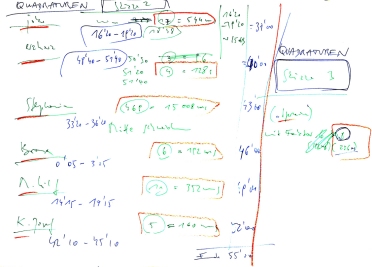
Sketch: time grids for Quadraturen Ib ("Cityportrait Graz"), 1995-97 - the 6 sections of the piece:
1. Jakominiplatz 544ms, 2. Kaffee Erzherzog Johann 128ms, 3. Stephaniensaal 15008ms,
4. Bronx 192ms, 5. Kirche Maria Hilf 352ms, 6. Kaiser Josef Platz 160ms
![]()
![]()
QUADRATUREN II
("RAUM DER ERKENNTNIS/VERTREIBUNG")
("Room of Knowledge/Expulsion")
6 loudspeakers on high pedestals, 6 black rectangles, inscription
- WP: Kunsthalle am Karlsplatz, Wien, 2002
> listen to extract from stereo-mix
> deutsche Dokumentation zu Quadraturen II
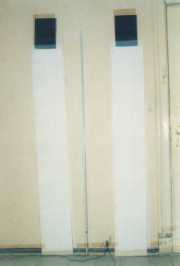 |
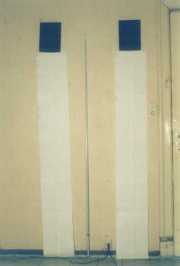 |
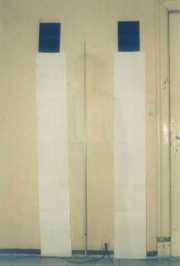 |
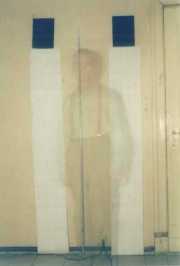 |
(Study for Quadraturen II, 4 photographs, 1998)
The base materials of Quadraturen II are 6 speeches - by Lenin, Hitler, Gandhi, M.L.King Jr., Kennedy, and Castro; all of them unified by the same slow grid (pulse) of 270 ms and reproduced in white noise.
Each of the 6 channels leads to a "sculpture" consisting of a loudspeaker for a head and a pedestal for a body, with each individual column "one head" taller than the visitor so that the loudspeakers are just above our heads. The columns are positioned equidistantly in a straight line and all together in their own separate room.

When one enters the room one dives into a relatively loud, room-filling noise groove, which many visitors at first feel very comfortable with. After some habituation one begins to separate the 6 columns' different signals. This the perfect moment to discover the small inscription affixed on the columns: each just a little too low and the letters just a little too small, so that one has to bow one's head before the column in order to be able to read the content of the inscription - which is 1 of the 6 names: Lenin, Hitler, Gandhi, M.L.King, Kennedy, Castro
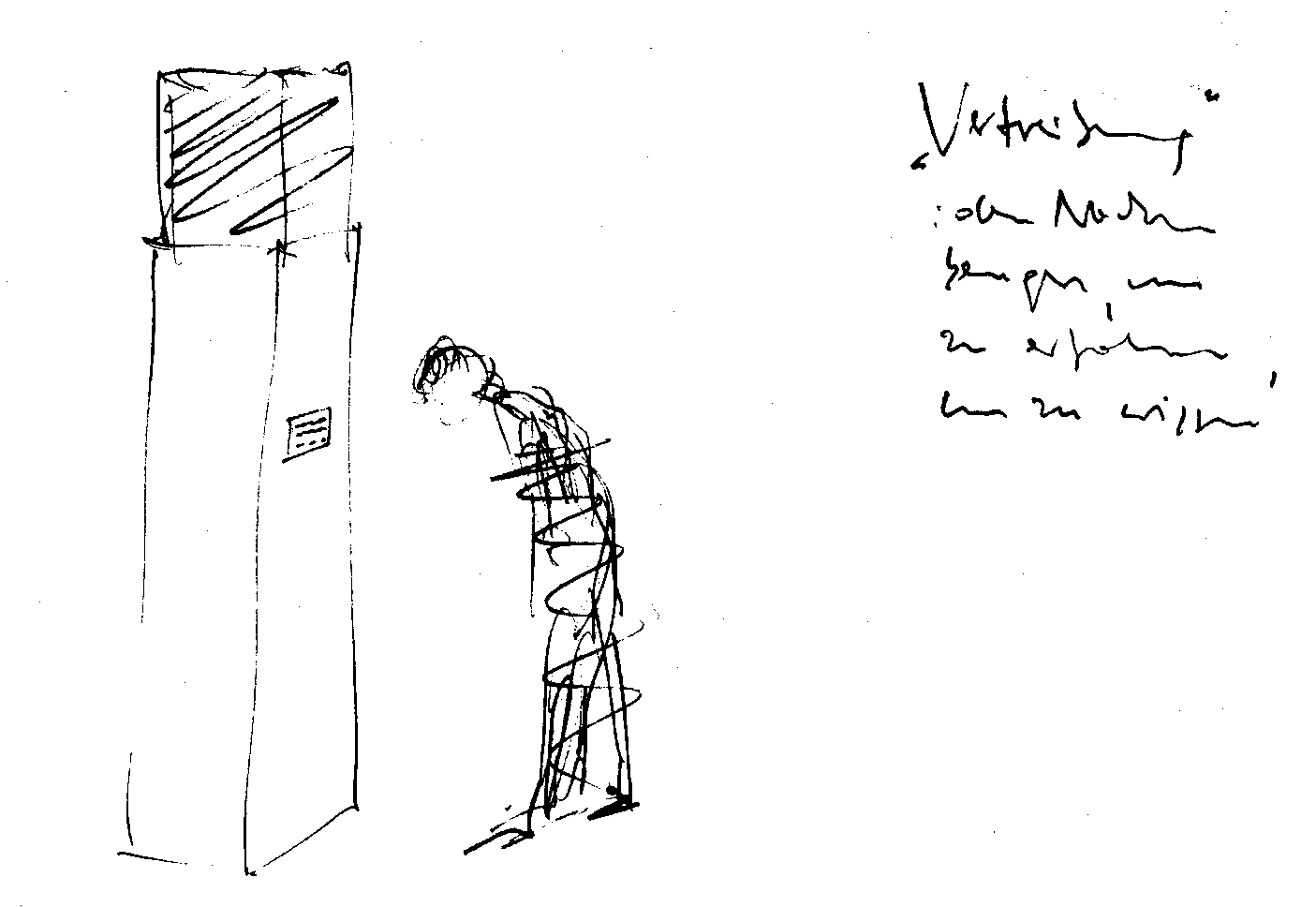

(one of the 6 small inscribed plaques)
Togehter with this information one is able to identify some timbral charcteristics of each loudspeaker with the given name. A black rectangle behind each loudspeaker helps the the visitor to find the point of identification in space where each signal is best separated. And at this moment the visitor's feelings about the situation begin to change...
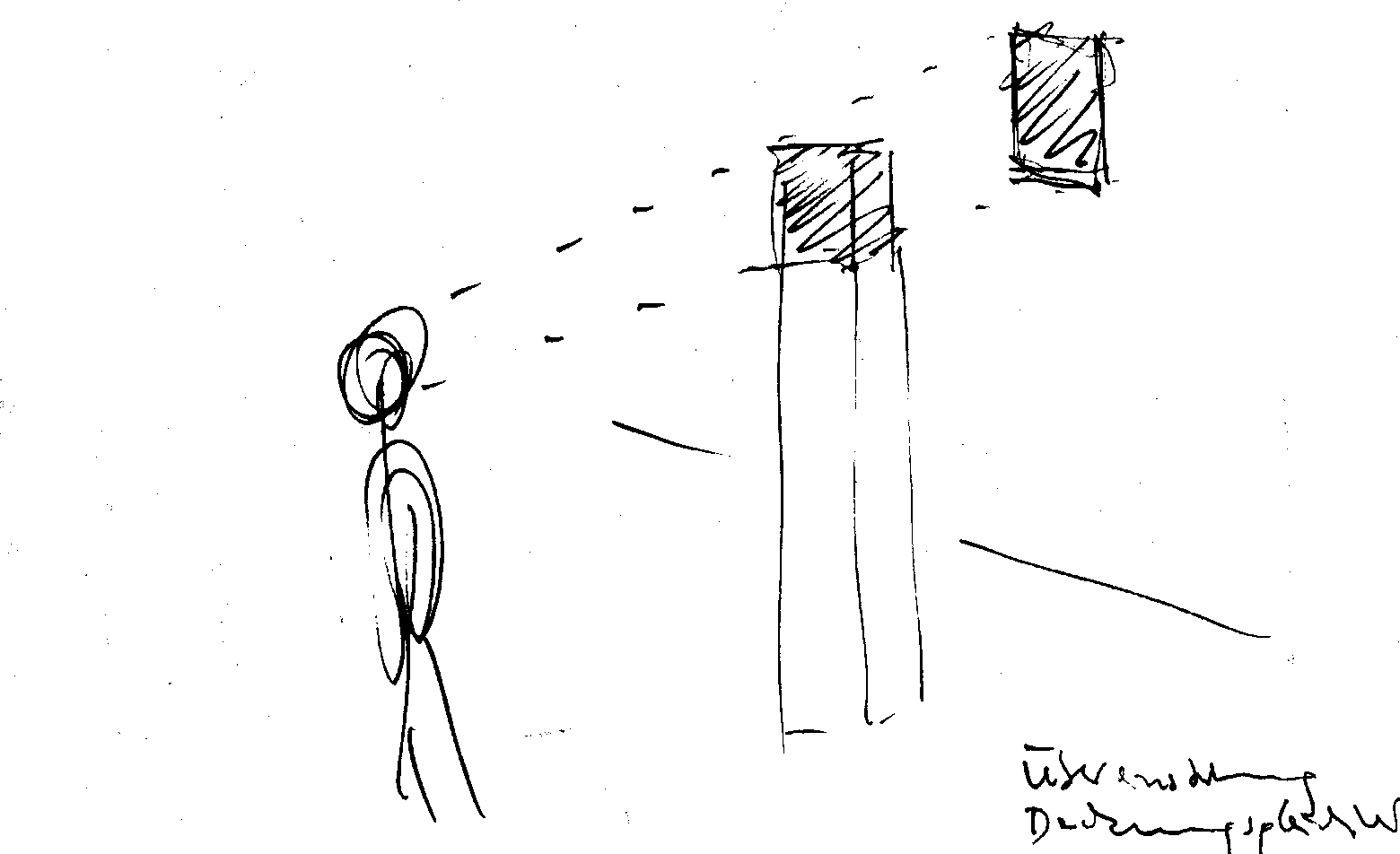
So, the piece is also a drama beginning with an invitation to enter an agreeable space, but ends with the expulsion from it.
Frequence grid: semitones
Time grid: 270ms for each speech, synchrionized
Reproduced in white noise

(one of the 6 columns with black rectangle and inscription, at the Kunsthalle am Karlsplatz realization, Vienna, 2002)
Requirements: a separate space, computer, 6 loudspeakers, 6 pedestals, 6 black rectangels (any material), inscriptions
Technician: Winfried Ritsch, Graz, Austria (who has programmed and reserved a special computer just for driving this installation)
Software design: Thomas Musil, IEM Graz
Design: Ursula Musil, Vienna
Construction of pedestals: Helmut Kaplan, Graz, Austria (steel scaffolds covered with fabric)
Set up time: 6 hours
Duration of the piece: 6 70-minute channels, endless loop
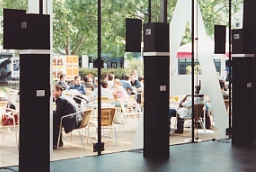

Vertreibung
... eigentlich bin ich noch lange nicht an der (hier) ausgestellten/proklamierten Wirklichkeit angekommen. Das eigentliche Thema ist der Wahrnehmungswechsel, der Moment, in dem man rausfliegt aus der ästhetischen Wahrnehmung (aus dem Paradies) und wo durch Assoziierungen/Denken/Wissen das reine Schauen/Hören - das dennoch mein einziger Gegenstand ist - verlassen werden muß. Ich inszeniere sozusagen die Vertreibung aus dem Paradies der Wahrnehmung, das Hineingestelltwerden in eine Welt sogenannter Realitäten, in der die Sinne einen schwachen Stellenwert haben, und stattdessen die Erziehung, die Moral, die Politik - lauter Dinge, die es zuerst einmal nur im Kopf gibt - das Feld bestimmen. Es ist, wie an einem blühenden Baum vorbeigehen und ihn bemerken, indem ich ihn rieche! Das ist das Pardies. Aber in der nächsten Sekunde sehe ich den Baum, und denke: Magnolienbaum; und damit bin ich wieder (wieder und wieder) aus dem Paradies hinausgeworfen. Es ist dies der Versuch, den Rauswurf als solchen, den Moment des Wechsels von Wahrnehmungweisen zu erfassen ... (P.A.)

(Drawing for Quadraturen II)
> listen
other loudspeaker sketches 2001/2003
"Das Auge leitet diese inszenierte Austreibung: Von dem Moment an, in dem man die Beschriftung auf der Klangsäule entdeckt und die Überschriften liest, unterstützen visuelle Assoziationen eine abstrakte Zeichendeutung im Sinne von Symptomen bzw. Spuren von Abwesenden. Die Lautsprechersäulen werden zum Stimmenersatz, zum Phantomerlebnis der körperlosen „bedeutungsvollen“ Stimmen der Geschichte. Der Zeichenverweis bzw. das Gleiten des Sinns wird fortan vornehmlich von der Kategorie der Drittheit geleitet. Die groove-artigen, rauschenden Gesänge ermöglichen zuerst eher taktile Erlebnisse, die allmählich gespenstisch werden: Als ob die abwesenden Herren der Stimmen Anspruch auf ihren Körper hätten und dadurch eine Vertreibung des paradiesischen Ist-Zustandes (Erstheit) der Wahrnehmung veranlassen."
(Aus: Chico Mello "Mimesis und musikalische Konstruktion", Shaker Verlag, Aachen 2010)
![]()
![]()
QUADRATUREN III ("WIRKLICHKEIT")
("Reality"), studies for computer-controlled player piano;
in collaboration with Winfried Ritsch: auto-piano player
IIIa "Gegrüßet seist Du Maria", 22"
- WP: Porgy & Bess, Wien 2004
> listen to the entire piece
> deutscher Text zum Stück
> CD: tonto #25
> Notation
"Eine beispielhafte Nähe zwischen Musik und Sprache ist bei Quadraturen IIIa zu beobachten. Hier dient als Eingangsmaterial eine Aufnahme des katholischen Gebetes „Gegrüßet seist Du Maria“. Die feine Auflösung bei der Klavierwiedergabe führt zu schnell vibrierenden Ikti, wodurch für den, der den Text bereits kennt, einige Wörter verständlich werden. Das kurze Stück beruht auf dem einmal vollständig vorgetragenen Gebet. (...) Die konstant enge Rasterung sowie die daraus resultierenden engen chromatischen Cluster bewirken, daß die Mimesis hier im Sinne einer Simulation von Sprache erlebt wird. Besonders in dem tiefen, männlichen Register schaltet das Hören in den Sprachidentifizierungsmodus, selbst wenn man den Text nicht wirklich versteht. Das melodische Hören der Cluster, d.h. die primäre Fokussierung auf Tonhöhenverhältnisse, tritt hier in den Hintergrund, auch wenn ein „musikalisches“ Instrument als Hörquelle dient. Es scheint so, als wäre das Klavier fähig, eine Art von „lexicoding“ zu vermitteln."
(Aus: Chico Mello "Mimesis und musikalische Konstruktion", Shaker Verlag, Aachen 2010)
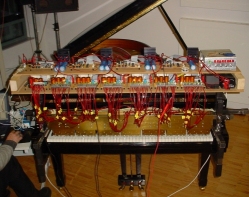
(in construction: "Kantor", the first version of the auto-piano player)
IIIb "Guten Abend bei der Zeit im Bild", ca.12'
- WP: Großer Sendesall, Wien 2002
> listen detail
> deutscher Text zum Stück
> CD: tonto #25
"Eine Sequenz von immer enger gerasterten Versionen ein und desselben Fragments, die dessen akustische Konstitution beleuchten und dabei verborgene harmonische Qualitäten freilegen. Statt Variation oder Thema gibt es lediglich immer dichtere, „präzisere“ „Klangbeschreibungen“ des Gleichen. In diesem Verdichtungsprozess entsteht der irritierende Eindruck eines Accelerandos, als werde das Ausgangsmaterial kontinuierlich beschleunigt – ein Effekt, der gewöhnlich beim schnellen Abspielen von Tonaufnahmen eintritt. In Wahrheit werden die Abschnitte nicht kürzer, die Zeit nicht komprimiert, sondern die das Ausgangsmaterial strukturierenden Raster verkleinert. Dies erzeugt ein paradoxes statisches Accelerando, das die traditionelle Hörerwartung verwirrt."
(Aus: Chico Mello "Mimesis und musikalische Konstruktion", Shaker Verlag, Aachen 2010)
IIIc "Fidelito/La Revolución y las Mujeres", 55'25"

WP: resonance104.4FM, London 2004
first live performance: Sporfestival, Gallery Spanien, Aarhus 2010
> listen to the beginning of the piece
> CD: tonto #30
Quadraturen III is, in opposition to the otherwise fixed and finished Quadraturen I, II, IV and V, an open work - or, itself a series within the series. Therefore, Quadraturen III consists of an open number of installation- and concert-pieces for computer-controlled piano, all of them concerned with the reproduction of concrete sounds, street noise, speech, -reality -, via the sound-repertoire of the piano.
"Fidelito/La Revolución y las Mujeres" ("Fidelito/the Revolution and the Women"), the third of its pieces uses as material three of eight sides of the 4 records comprising a single speech given by Fidel Castro during a congress of the "revolutionary women of Cuba" in 1974. All of the sounds of the piece result from the direct transfer of the sounds of the record - the needle, the scratches - and it's content - the voice of Fidel Castro, the applause and jubilation of the mostly female audience - into the sound world of the player piano. This transfer might be described as the manipulation of the grid, or, in photographical terms, as the enlarging or diminution of the grain, and the variation of contrast between fore- and background. A larger grain stands for a slower piano and a piano - as it then plays within a more human range of potentialities - that at least reminds one of a piano. A smaller grain stands for a faster piano, or for an increase in tempo such that one can no longer distinguish single attacks as tempo and the sounds therefore become continuous. In such sections it becomes audible that we are listening to a voice and - with some practice and acclimation - we can even understand a few words of Castro's Spanish.
And yet listening to a voice seems incompatible with listening to a piano. Comparable to those 3D-pictures where one first sees a mass of abstract ornaments and then - with practice squinting - discovers a three-dimensional object. But one can never have both at once: the ornament or the object, the piano or the voice.
(A few examples of words that I at least think I understand:
I/0:30 "queridas invidadas, (I/0:37) queridas compañeros"
I/1:56 "...delegatión (I/1:59) de las mujeres revolucionarias de todo el mundo"
I/2:29 "Valentina Tereshkova, (I/2:34) Angela Davis"
I/2:44 "la presencia numerosa (I/2:52) de las mujeres de las pueblos hermanos de América Latina, (I/3:02) la presencia (I/3:09) de las mujeres árabes"
etc.)
listen to the beginning of the piece
English notes for "Fidelito/La Revolución y las Mujeres", pdf
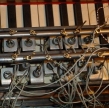
(the prototype: one piano octave, 2002)
German text for Quadraturen IIIa and IIIb, which are both based on recordings of German (Austrian) text/sound materials (IIIa uses a prayer, IIIb, the daily tv-news):
QUADRATUREN III "WIRKLICHKEIT"
Studien für mechanisches Klavier
Die Quadraturen III sind, im Gegensatz zu den (inzwischen) abgeschlossenen Quadraturen I, II, IV und V, ein offenes Werk, oder selbst eine Serie in der Serie. Jedes einzelene seiner Stücke beschäftigt sich auf seine Weise mit der Wiedergabe von konkreten Klängen, Umweltgeräuschen, Sprache, durch ein computergesteuertes Klavier. Eine wirklich schallrealistische Wiedergabe etwa von Sprache durch ein Klavier ist unmöglich. Und doch: es ist wie bei diesen 3-D-Bildern, wo man zuerst nur ein ornamentales Bild vor sich hat, aber schließlich, und mit etwas Übung, einen konkreten Gegenstand darin erkennen kann. Genauso ist es mit dem Klavier in diesem Stück: man hört entweder ein Klavier-Ornament, - oder man versteht plötzlich einen Satz! Das Klavier spricht zu Ihnen!
Um das Einüben in diese Hörweise zu erleichtern, greifen die beiden ersten Studien auf Material zurück, das - in Österreich - einen gewissen Bekanntheitsgrad aufweist.
Das erste Stück dauert gerade mal 22 Sekunden und besteht aus dem "Gegrüßet seist Du Maria"-Gebet. Für Nicht-Katholiken hier der kurze Text: "Gegrüßet seist Du Maria/ voller Gnaden/ der Herr ist mit Dir/ Du bist gebenedeit unter den Weibern/ und gebenedeit ist die Frucht Deines Leibes, Jesus/ Heilige Maria, Mutter Gottes/ bitte für uns Sünder/ jetzt, und in der Stunde unseres Todes/ Amen."
Das zweite Stück dauert etwa 12 Minuten und verwendet Material aus der allabendlichen Nachrichtensendung "Zeit im Bild". Es beginnt mit einer Introduktion, in der 8 mal dieselben 2 Sekunden Gegenstand der Reproduktion sind, und zwar in immer größerer Auflösung: Beim ersten Mal sind es nur 2 Akkorde, und bei der 8. Wiederholung ist man bei der Fast-Verständlichkeit angelangt: "Guten Abend bei der Zeit im Bild". Es folgt ein knapp 4-minütiges Nachrichtenresponsorium aus Männer- und Frauenstimmen, beginnend mit: "Die israelische Armee hat heute die Stadt Rammallah im Westjordanland besetzt..." Alles in hoher Auflösung; immer wieder dringen Worte, wie "Uno-General-sekretär Annan" oder "Palistinenserführer Arafat" nahe an die Verständlichkeit heran. Der dritte Abschnitt des Stückes schließlich wiederholt 8 mal einen Abschnitt von einer Minute, der u.a. die Zeit-im-Bild-Eröffnungsmelodie enthält, und genau mit dem bereits gehörten "Guten Abend bei der Zeit im Bild" endet - wieder in denselben 8 Stufen zunehmend dichter werdender Rasterung, die gewissermaßen zwischen Klavierklang und Sprache, zwischen "Musik" und "Wirklichkeit" vermitteln.

(the model for the auto-piano player: Trimpin's "Vorsetzer" Los Angeles, 2001)
The piano imitates the human voice and at the same time operates as an alienated recording and reproducing device. It has thus been replaced as traditional musical instrument: no artist operates it in order to play music. It becomes an oversized phonograph which is not used for the production of previously composed music but for the reproduction of the human voice. The sudden comprehensibility of single words, whenever the piano becomes the faithful representation of language, equally has the effect of a phantom’s abrupt appearance: the close up reality of the voice is a ghostly apparition – as though the “forbidden” border between dream (music) and reality (language) had been crossed. The “talking” piano represents a mimetic machine which is capable of producing the mimesis of a mimesis: it absorbs, it imitates what has already previously been imitated, namely the recording of sound.
From: Chico Mello “Mimesis und musikalische Konstruktion”, Shaker Verlag, Aachen 2010
Das Stück präsentiert sich als eine Art allumfassender Simulation. Es gibt nicht nur keinen Pianisten, sondern auch keine Sprache und keine Musik. Diese werden durch eine mechanische, ‚falsche’ Übersetzung simuliert, angedeutet, entcharakterisiert, ineinander verwandelt und verwechselt. Dadurch wird die Arbitrarität der sprachlichen und musikalischen Zeichen (Symbole) außer Kraft gesetzt: Ihre Deutungsbereiche annullieren sich gegenseitig.
Aus: Chico Mello "Mimesis und musikalische Konstruktion", Shaker Verlag, Aachen 2010
further pieces from the Quadraturen III series:
IIId "Portrait of my parents", endless
-
WP: Großer Minoritensaal, Graz 2006
sound-installation for 2 computer-controlled player pianos
a second auto-piano player has been built for this endlessly playing installation piece; the basic material is a recording of my parents reciting the rosary, an endless Catholic responsorial prayer;
my father: left piano, my mother: right piano
listen to the beginning of the piece
Text of the sound sample:
(Left Piano) "Im Namen des Vaters und des Sohnes und des Heiligen Geistes Amen Vater unser im Himmel Geheiligt werde dein Name Dein Reich komme Dein Wille geschehe wie im Himmel so auf Erden"
(Right Piano) "Unser tägliches Brot gib uns heute Und vergib uns unsere Schuld wie auch wir vergeben unseren Schuldigern Und führe uns nicht in Versuchung sondern erlöse uns von dem Bösen Amen"
(Left Piano) "Gegrüßet seist du Maria Voll der Gnade Der Herr ist mit dir Du bist gebenedeit unter den Frauen und gebenedeit ist die Frucht deines Leibes Jesus"
(Right Piano) "Heilige Maria Mutter Gottes Bitte für uns Sünder Jetzt und in der Stunde unseres Todes Amen"
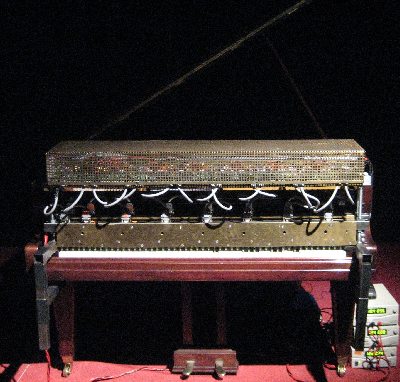
"Millitron", the second player has been constructed by Winfried Ritsch for this piece; but actually the first occasion where two parallel computer-controlled player pianos are in action was the 7th act of the "City Opera".
More about "Portrait of my parents", including photographs
IIIe "Schaufensterstück", endless
- WP: Medienkunstlabor, Kunsthaus Graz, 2004
interactive real-time version:
a microphone picks up input outside, the piano realizes this input inside in real-time (time delay is the size of the grid, e.g. 100 ms);
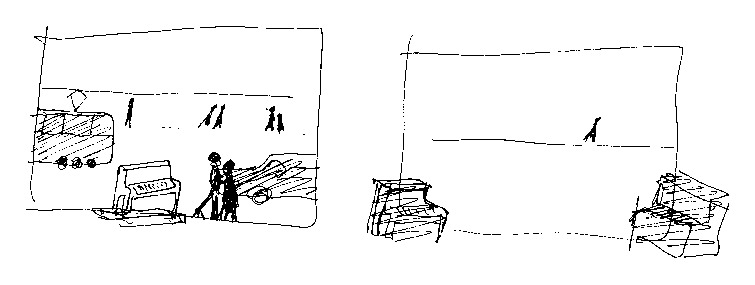
drawing for "Schaufensterstück" in two versions: for one and for two pianos
More about "display-window piece", including sound examples
IIIf "A Letter from Schoenberg", reading piece with player piano
-
Schoenberg's original voice tranfered to piano
WP: EU-Ministerkonferenz, Helmut-List-Halle, Graz, 2006
for player piano and an audience reading the text while hearing the piece, 1'49"
The project: please read and listen "A Letter from Schoenberg"
IIIg "Audioanalyse / Die Auflösung / Freud in England / Le grain de la voix"
-
für computer-gesteuertes Klavier und Videotext, 4'00"
WP: MAK Wien, 2006
The project: "Audioanalyse / Die Auflösung / Freud in England / Le grain de la voix"
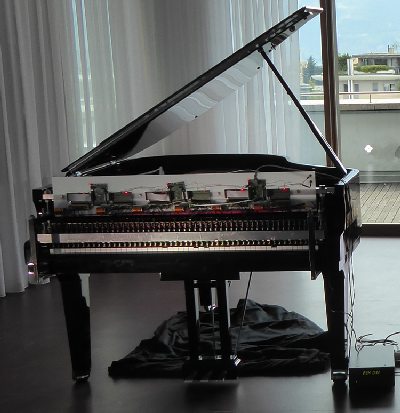
Since 2010, "Rhea", the 3rd generation of the auto-piano player, was in action.
Visit also Winfried Ritsch's Documentation on the auto-piano player projects
IIIh "Deus Cantando (God, Singing)"
-
for computer-controlled piano and screened text, 1'43"
WP: World Venice Forum 2009
The project: "Deus Cantando (God, Singing)"
IIIi "The Truth, or: How To Teach The Piano Chinese"
-
for computer-controlled piano and screened text, 10'
WP: Shanghai Biennale 2014
more about "The Truth..."
IIIj "Music's Over"
-
for computer-controlled piano, 14'44"
WP: Gray Center, Chicago 2020
more about "Music's Over"
Frequence grid: semitones
Time grid: variable
Reproduced on a piano
Constructor of the Computer Controlled Piano Player: Winfried Ritsch
Software design: Thomas Musil, IEM Graz
Requirements: any (grand) piano, plus the auto-piano player, distributed by Zeitvertrieb Wien Berlin
the weight of the auto-piano player is just 35kg
it can be attached to any piano
the controlling computer comes from Winfried Ritsch, Graz, Austria, who is also required for set-up of the instrument
duration of attachment: 3-4 hours
duration of detachment: 5 minutes
"Nulla è più interessante, per un poeta futurista, che l’agitarsi della tastiera di un pianoforte meccanico." (F.T.Marinetti, 1912)
siehe auch / see also:
Speaking Piano
Der Donaufürst (music and language 1979)
Phonorealism
![]()
![]()
QUADRATUREN IV
("SELBSTPORTRAIT MIT BERLIN")
("Selfportrait with Berlin"), for ensemble and CD
fl,2cl,2vl,va,2vc,3keybooards, 17'
- WP: Berliner Festspiele 1998, Kammermusiksaal der Philharmonie, Ensemble Klangforum Wien, Cond. Silvain Cambreling
> deutscher Text zu den Quadraturen IV und V
> Björn Gottstein über Quadraturen IV und über die Musik als Subjekt (pdf, 12KB)
> score: one page from the first part
> listen (detail of first from six parts)
> CD: Kairos 0012192KAI
The self-portrait is in some way Byzantine, the perspective is reversed: it's not how people see me, but what I see (and hear) that forms the subject of the piece. In other words the portrait reveals the view of the observer rather than the observer himself.
The original material consists of 6 different microphone recordings with ambient sounds of the city. These form both the (raw) accompaniment to and basic material for the instruments, which, parallel to the recordings, play the analysis resulting from the temporal and spectral scan of the latter. Here, one might also speak of the maximum integration of instrumental sounds in environmental recordings.
In other words, the sound of the ensemble can in principle be compared with that of the recordings. The music becomes an observer of reality. Compared with "reality", "music" is defined in terms of a scanner (with horizontal rhythm and vertical pitch). To be precise, in terms of a very rough scanner which hobbles far behind the complexity of reality. But at the same time, such hobbling reflects the truth of the observation process as well as being an aesthetic phenomenon in itself.

5 from 6 parts of the piece, the time-changes with its overlapping zones; drawing from note-books
Frequence grid: semitones
Time grid: changing
Reproduced by camber orchestra playing synchronized to the original - unmanipulated - recordings of city noises
Requirements:
Ensemble: fl, 2cl, 2vl, va, 2vc, 3 keybooards (3 pianos, or a mix of pianos and electronic keyboards) CD: mono sound-track plus click-track for conductor Amplification: 2 or more onstage loudspeakers
Analysis software designed by Thomas Musil, IEM Graz

(spectral analysis in notes, pre-study for Quadraturen IV, designed by Thomas Musil)
> listen (detail of first from six parts)
![]()
QUADRATUREN V
("MUSIK")
("Music"), for orchestra
4fl,4cl,4hrn,2trp,2trb,12vlI,12vlII,10va,8vc,6db, 16:41
WP: Donaueschinger Musiktage 2000, SWR Symphony Orchestra, Cond. Silvain Cambreling
> deutscher Text zu den Quadraturen IV und V
> one page from the score, pdf 289KB
> listen
> CD: col legno WWE 4CD 20201
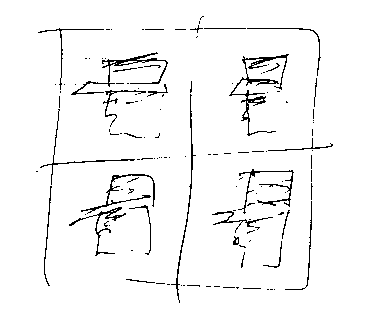
(4 Vopos, drawing for Quadraturen V))
Quadraturen V is - in compositional terms - a machine that can write orchestral music. One simply inserts a cassette in one end, regardless of what recorded material it contains, and out of the other end of the machine emerge whole pages of printed music. I'm dreaming of course, for the process actually was a little more complicated; but what's true is: I have not written a single note (- and I am proud of that). Or at least this composition is not just made up of actual output, but is also comprised of the production process itself, from the conception and transformation of the data analyzed in note values right down to a conductor's score and orchestral parts. The composition is not so much the acoustic orchestral piece, but the orchestral music writing "machine", the electronic production process itself.
My little factory consisted basically of Thomas Musil who programmed the analysis-to-midi tool, and Nadar Mashayeki for laying out a practicable score and parts (midi to score). The almost industrial production method may be understood as a reply to the orchestra. For the orchestra is an apparatus of reproduction, not one of production. In Quadraturen V reproduction has become the object of reproduction. An object squared: screening original material in order to have it reproduced by orchestral instruments. Here we encounter no environmental din, no one language, it is music itself. Music, because there is still a vague chance that the original material might become sufficiently recognizable without electronic support. The aim is to generate a kind of utopian borderland between a place of purely sonic reality and one of musical reminiscence. It is utopian because that which does not ("ou") really exist is the location ("topos"). In any case it becomes possible to oscillate in an ideal way between listening and remembering via a kind of locus amoenus. The object in this case is the "Hymn" (anthem) of the former German Democratic Republic, composed by Hans Eisler. One verse at a time, the music is employed on 10 occasions. The object must be well-known to be recalled.

(application for entry into the GDR)
Varying screen tempi in various constellations helps the object become more recognizable or less, according to the specific case. In contrast, the spectral screen remains constant, in 3/4 tones, i.e. eight notes to the octave. This is very close to the seven non-equidistant notes of the diatonic scale but also just far enough removed from it. This means, however, that by no means has everything been done to render the "original" recognizable. The aim is to have it disappear just as it comes into view.
Frequence grid: 3/4 tones (150 cent)
Time grid: changing, and in different layers (polyrhythmic)
Reproduced by symphony orchestra
Composition Software: Thomas Musil, IEM Graz;
Score and Parts: Nader Mashayekhi
Requirements:
Orchestra: (symphony orchestra) 4fl, 4cl, 4hrn, 2trp, 2trb, 12vlI, 12vlII, 10va, 8vc, 6db
Score and orchestra materials: Zeitvertrieb Wien Berlin

(5 electric chairs, sketches after Warhol for Quadraturen V)
